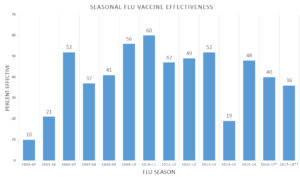Well it appears that the flu season is once again upon us and healthcare officials are encouraging everyone to be vaccinated.
Most heed the warnings and notices and head right out to get their flu shots.
But what if you followed all of the advice and did everything by the book and still caught the flu? Does it mean that your vaccination was bogus? Did health officials lie?
Well, not exactly.

You see, there are many different variations of what we have come to know as the “flu” — The “flu”, over the years, has been used to describe nearly anything that might cause us to not feel well, and generally speaking, the flu does seem to cover quite a bit when you stop to consider just how many strains and sub-strains of the flu there actually are.
The flu, or Influenza, as it’s commonly referred to in medical circles, comes in three main types:
1) Influenza A
2) Influenza B
3) Influenza C
Among these main types are what we like to call sub-types, or subdivisions.
The influenza A virus, for instance, can be subdivided into different serotypes based on the type of hemagglutinin and neuraminidase. The “H” in “H1N1” for example refers to hemagglutinin (HA) and “N” in “H1N1” refers to neuraminidase (NA). There are 16 different types of HA and 9 different types of NA, therefore, there are potentially 144 different sub-types of influenza A viruses.
Among them, two sub-types of influenza A, H1N1 and H3N2, most commonly infect humans. For each sub-type virus, the hemagglutinin gene mutates all the time and hence there are many variants of the same sub-type viruses, and hence the need to change the virus strain for seasonal flu vaccines on an annual basis.
So you got your flu shot and you still got sick.
Since there are so many different sub-types, or subdivisions of just the type A virus, a lot of work goes into determining just which vaccine should be used for the upcoming flu season. Health officials usually do a pretty good job of getting it right, but sometimes, even with all of their combined calculative effort, it can still come out wrong. The right vaccine could have been selected for the season only to have the strain change or drift before the start of flu season.
And so maybe this year health officials got it right, but you just ended up with a strain that wasn’t covered in the vaccine you received. Maybe your version of the flu had drifted a little before the season started.
The flu virus in and of itself is a constantly evolving thing. Pitching and yawing tither and yon on a seemingly monthly basis. Coming up with a new or different vaccine every year might remind some of us of that whack-a-mole game we like to play at the county fair, although getting to a right vaccine is somewhat more scientific.

The average rate of effectiveness of any annual vaccine can range anywhere between 37% to 60% — You may have noticed the large swing in percentages, or most notably the lowest percentage. There isn’t just one single reason for the swings in statistics.
When you stop and consider the variants, or subdivisions related to just the Influenza A virus itself, and then pile on all of the millions of people who never wash their hands, or who never cover their mouth when they cough or sneeze, or as a general rule fail to practice every day personal hygiene, one might come away with the notion of just how good these statistics actually do look.
Our medical professionals aren’t gods or miracle workers by any stretch – They are just a cog in your every day wheel of health — Your health depends on you too — Staying healthy during the flu season, or any other season for that matter, is a team sport and we all need to be team players when it comes down to our health.






